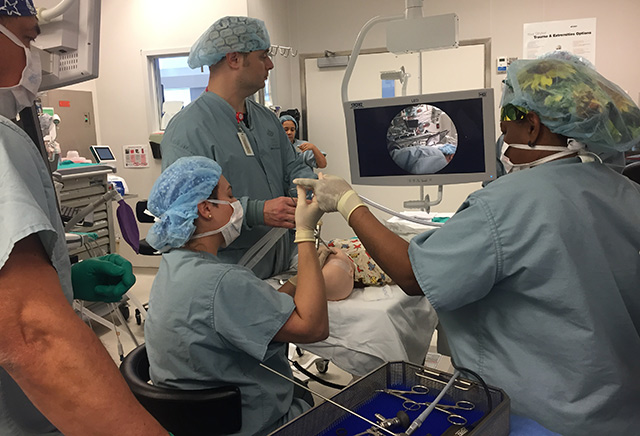 As the Department of Surgery continues to expand in the community at Texas Children’s Hospital West Campus and Texas Children’s Hospital The Woodlands, ongoing training is needed to be able to offer high-level surgical procedures.
As the Department of Surgery continues to expand in the community at Texas Children’s Hospital West Campus and Texas Children’s Hospital The Woodlands, ongoing training is needed to be able to offer high-level surgical procedures.
Otolaryngologists Dr. Deidre Larrier and Dr. Mary Frances Musso have been leading that charge when it comes to training operating room staff in the removal of aerodigestive foreign bodies – obstructions in the esophagus and/or trachea.
Such obstructions can be emergent, and require rapid response using specialized equipment. During a four-year period between 2011 and 2015, there were 556 obstruction cases, 64 of which occurred at West Campus.
“The instruments used in obstruction procedures are very specific and are not used in general surgical procedures,” Larrier said. “Thus the need for supplemental training for our OR support staff.”
Led by Larrier, the training is for OR nurses and scrub technicians. The half-day course includes a lecture, hands-on skills lab, and in-situ simulation.
Musso is taking the Texas Children’s Hospital simulation instructor course this summer, which will allow her to enhance her mentoring skills during these sessions. Larrier is already an instructor and was instrumental in helping establish simulation education at the hospital. She leads the otolaryngology simulation sessions for not only OR staff but also residents, fellows, and mid-level providers. She recently led a training for Advanced Practice Providers on tonsillectomy surgery and the complications that can occur following such procedures.
“Dr. Larrier’s training of OR staff in the removal of aerodigestive foreign bodies and esophageal obstructions was very well received here in the Woodlands,” said Dr. Charles Hughes, a member of the otolaryngology team in The Woodlands. “Both Ramon Enad and Tom Cunningham, our OR staff leads, felt it was extremely beneficial for staff, in that these procedures are high risk and infrequent.”
Musso said, West Campus staff is very appreciative of the training and that it has helped improve their skills using this specialized equipment and treating these patients. “We plan to repeat this training session annually at West Campus to maintain the staff’s skill level.”
Larrier said she will gladly continue such training, something she views as a testament to how much the surgical capability at West Campus and in The Woodlands has grown.



